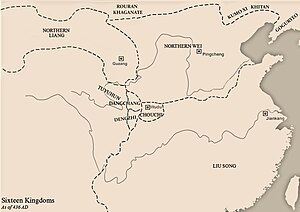
Back Şimali Lyan Azerbaijani Северна Лян Bulgarian Nördliche Liang German Liang septentrional French Pet-Liòng HAK Sjeverni Liang Croatian Liang Utara ID 北涼 Japanese 북량 Korean Умард Лян Mongolian
Northern Liang (北涼) 建康 (397–399), 涼 (399–401, 431–433), 張掖 (401–412), 河西 (412–431, 433–441, 442–460), 酒泉 (441–442) | |||||||||||||||
|---|---|---|---|---|---|---|---|---|---|---|---|---|---|---|---|
| |||||||||||||||
Northern Liang and other Asian polities in 400 AD | |||||||||||||||
 Northern Liang at its greatest extent in 436 AD | |||||||||||||||
| Status | Vassal of Later Qin, Eastern Jin, Northern Wei, Liu Song | ||||||||||||||
| Capital | Jiankang (397–398) Zhangye (398–412) Guzang (412–439) Jiuquan (440–441) Dunhuang (441–442) | ||||||||||||||
| Capital-in-exile | Shanshan (442) Gaochang (442–460) | ||||||||||||||
| Government | Monarchy | ||||||||||||||
| Prince | |||||||||||||||
• 397–401 | Duan Ye | ||||||||||||||
• 401–433 | Juqu Mengxun | ||||||||||||||
• 433–439 | Juqu Mujian | ||||||||||||||
• 442–444 | Juqu Wuhui | ||||||||||||||
• 444–460 | Juqu Anzhou | ||||||||||||||
| |||||||||||||||
| Today part of | China Mongolia | ||||||||||||||
The Northern Liang (Chinese: 北涼; pinyin: Běi Liáng; 397–439) was a dynastic state of China and one of the Sixteen Kingdoms in Chinese history. It was ruled by the Juqu (沮渠) family of Lushuihu (盧水胡) origin, a branch of the Xiongnu.[3] Although Duan Ye of Han ethnicity was initially enthroned as the Northern Liang ruler with support from the Juqu clan, Duan was subsequently overthrown in 401 and Juqu Mengxun was proclaimed monarch.
All rulers of the Northern Liang proclaimed themselves "wang" (translatable as either "prince" or "king").
- ^ "中央研究院網站".
- ^ Zizhi Tongjian, vol. 123.
- ^ Xiong, Victor (2017). Historical Dictionary of Medieval China. Rowman & Littlefield. p. 315. ISBN 9781442276161.
© MMXXIII Rich X Search. We shall prevail. All rights reserved. Rich X Search
